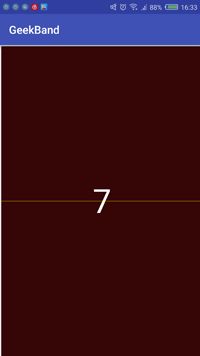1 dp,sp,px
- 名词解释
- px:像素,就是屏幕上的点,如图片的像素大小为32*32,这就是指的像素
- dpi:每英寸点数,即每英寸包括的像素个数,用对角线上像素点数/对角线长度。
- dp:设备独立像素,与像素密度密切相关。在dpi=160的设备上,1dp=1px.
- sp:相当于dp,常用于文字修饰
- dip:=dp
- 使用
- 常用尺寸大小dp
- 文字尺寸用sp
- 在屏幕上画一个分割线可以用px,比如1px
- m,h,xh,xxh,xxxh.1.5倍的等比
2 LayoutInflater
将xml文件解析为视图
- 获得LayoutInflater实例的三种方法
LayoutInflater m1 = getLayoutInflater()LayoutInflater layoutInflater = getSystemService(LATOU_INFLATER_SERVICE)LayoutInflater layoutInflater = LayoutInflater.from(Context)- 从源码来看,三种方法其实都是一种,就是第二种
/**
* Obtains the LayoutInflater from the given context.
*/
public static LayoutInflater from(Context context) {
LayoutInflater LayoutInflater =
(LayoutInflater) context.getSystemService(Context.LAYOUT_INFLATER_SERVICE);
if (LayoutInflater == null) {
throw new AssertionError("LayoutInflater not found.");
}
return LayoutInflater;
}
从上面from()的源码来看,方法里就调用了getSystemService(),所以殊途同归。
tips:getLayoutInflater()还没找到
3 提取布局属性:theme&style
当控件的很多属性有重合的时候,可以把它们相同的属性提取出来,这样可以减少代码的冗余度。
也可用parent继承已有的style,在代码中是这样引用的
4 如何自定义属性
深入理解android的自定义属性,写的更加易懂,以下参考了这篇博客。
- 创建属性
- value下新建资源文件,命名attrs_+类名
-
public static final class attr{
public static final int backgroundColor=0x7f0100b3;
}
public static final class styleable {
public static final int[] RedTextButton = {
0x7f0100b3, 0x7f0100b4
};
public static final int RedTextButton_backgroundColor = 0;
public static final int RedTextButton_textSize = 1;
}
所以有了这个标签,我们就可以只去关注这些属性的编写了,更加高效。
-
- 然后在CustomView代码中获取这些属性
public void init(Context context, AttributeSet attrs){
this.setOnClickListener(this);
TypedArray typedArray = context.obtainStyledAttributes(
attrs,R.styleable.RedTextButton);
mBackGroundColor = typedArray.getColor(
R.styleable.RedTextButton_backgroundColor, Color.BLUE);
mText = typedArray.getString(R.styleable.RedTextButton_text);
typedArray.recycle();
//
mTextSize = typedArray.getInteger(R.styleable.RedTextButton_textSize, 18);
}
AttributeSet:参数的集合,其实可以通过getAttributeName()和getAttributeValue()获得所有属性的key和value。但是为什么还要使用TypeArray呢?因为如果value是引用类型如"@string/app_name",那么它获得的value将是@+一串数字,如果要把这些数字解析出来,则还需要写代码完成这项工作,而TypeArray是简化了我们的工作。参考TextView获取属性的代码,可见系统也是这样做的
/*
* Look the appearance up without checking first if it exists because
* almost every TextView has one and it greatly simplifies the logic
* to be able to parse the appearance first and then let specific tags
* for this View override it.
*/
TypedArray a = theme.obtainStyledAttributes(attrs,
com.android.internal.R.styleable.TextViewAppearance, defStyleAttr, defStyleRes);
TypedArray appearance = null;
int ap = a.getResourceId(
com.android.internal.R.styleable.TextViewAppearance_textAppearance, -1);
a.recycle();
....
- 如果直接使用系统的属性,则直接在attrs.xml中声明
5 自定义控件的步骤
步骤如下:
- 自定义属性
- 在customView中获取这些属性
- 重写onMesure。老师没有说,但是不写好像有一丢丢的问题
- 重写onDraw。绘制
既然步骤知道了,那就开始。自定义属性和获取属性上面已经介绍一遍了,接下来就是重写一系列方法
- 重写draw方法
/**
*
* @param canvas 绘图工具
*/
@Override
protected void onDraw(Canvas canvas) {
super.onDraw(canvas);
mPanit.setTextSize(mTextSize);
//获取文字四周的矩形,文字,开始的位置,结束的位置,把文字的四周边距计算出来放在mRect中
mPanit.getTextBounds(mText, 0, mText.length(), mRect);
float textWidth = mRect.width();
float textHeight = mRect.height();
mPanit.setColor(mBackGroundColor);
canvas.drawRect(0f, 0f, getMeasuredWidth(),getMeasuredHeight() ,mPanit);
//中间一个白色的数字
mPanit.setColor(Color.WHITE);
canvas.drawText(mText, getWidth() / 2 - textWidth / 2, getHeight() / 2 + textHeight / 2, mPanit);
mPanit.setColor(Color.YELLOW);
canvas.drawLine(0, getHeight() / 2, getWidth(), getHeight() / 2, mPanit);
}
布局文件
显示如下
如果把宽高改成wrapcontent,则会变成(数字我设置了点击事件所以变了)。不符合
所以需要重写onMesure方法
重写之前了解 MeasureSpec 的 specMode,一共分为三种类型:
EXACTLY:一般表示设置了 明确值,或者 match_parent ;
AT_MOST:表示子控件限制在一个最大值内,一般为 wrap_content;
UNSPECIFIED:表示子控件像多大就多大,很少使用
@Override
protected void onMeasure(int widthMeasureSpec, int heightMeasureSpec) {
int widthMode = MeasureSpec.getMode(widthMeasureSpec);
int widthSize = MeasureSpec.getSize(widthMeasureSpec);
int heightMode = MeasureSpec.getMode(heightMeasureSpec);
int heightSize = MeasureSpec.getSize(heightMeasureSpec);
int width;
int height;
if (widthMode == MeasureSpec.EXACTLY){
width = widthSize;
}else {
mPanit.setTextSize(mTextSize);
//获取文字四周的矩形,文字,开始的位置,结束的位置,把文字的四周边距计算出来放在mRecr中
mPanit.getTextBounds(mText, 0, mText.length(), mRect);
int desired = getPaddingLeft() + getPaddingRight() + mRect.width();
width = desired;
}
if (heightMode == MeasureSpec.EXACTLY)
{
height = heightSize;
} else
{
mPanit.setTextSize(mTextSize);
//获取文字四周的矩形,文字,开始的位置,结束的位置,把文字的四周边距计算出来放在mRecr中
mPanit.getTextBounds(mText, 0, mText.length(), mRect);
int desired = (getPaddingTop() + getPaddingBottom() + mRect.height());
height = desired;
}
setMeasuredDimension(width, height);
}
然后wrapcontent就会变成
但是还有一个问题就是文字看上去不是那么居中,这篇博客关于文字居中写得特别的详细 怎么绘制居中文字,码着学习。
最后给view添加一个点击事件,点击一下数字会减少
@Override
public void onClick(View view) {
int mNumber = Integer.parseInt(mText);
if (mNumber > 0){
mNumber--;
}else {
mNumber = 10;
}
mText=String.valueOf(mNumber);
invalidate();
}
tips:
自定义控件水太深
我现在有点饿




